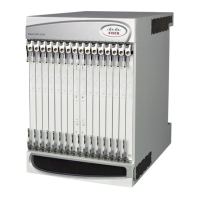Cisco ASR 5000 Series Thresholding Configuration Guide ▄
Chapter 18
PDSN Service Thresholds
PDSN Service thresholds generate alerts or alarms for the average number of calls setup. A threshold can be configured
to report this information for an entire context or for an individual PDSN service. Thresholds can also be configured for
A11 registration response failures, discarded A11 registration requests, discarded A11 registration acknowledgments,
and discarded PPP send packets for individual PDSN services.
Alerts or alarms are triggered for these PDSN thresholds based on the following rules:
Enter condition: When the actual average of call setups or actual number of failures or discards passes, or is
equal to, the configured Threshold value an alert or alarm is set.
Clear condition: When the actual average of call setups or actual number of failures or discards passes below
the Threshold value the alert or alarm is cleared.
If a trigger condition occurs within the polling interval, the alert or alarm is not generated until the end of the polling
interval.
The following table describes the possible methods for configuring PDSN Service thresholds:
To configure, go to
section:
This threshold keeps track of the average number of call setups for all PDSN services in a
context. When the actual average of call setups per polling period meets or exceeds the set
high threshold an alert or alarm is set.
Context-Level
PDSN Service
Thresholds
PDSN services send and receive A11 registration messages and PPP packets. The thresholds
in the PDSN Service-Level can be configured to monitor thresholds for A11 registration
response failures, discarded A11 registration requests, discarded A11 registration
acknowledgments, and discarded PPP send packets for individual PDSN services.
PDSN Service-
Level PDSN
Service Thresholds

